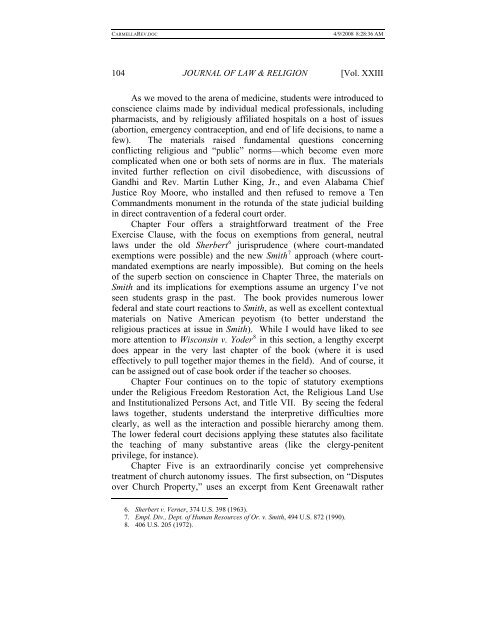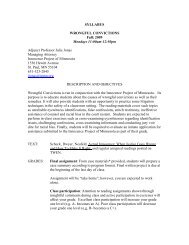LAW AND RELIGION: CASES AND MATERIALS - Hamline Law
LAW AND RELIGION: CASES AND MATERIALS - Hamline Law
LAW AND RELIGION: CASES AND MATERIALS - Hamline Law
You also want an ePaper? Increase the reach of your titles
YUMPU automatically turns print PDFs into web optimized ePapers that Google loves.
CARMELLAREV.DOC 4/9/2008 8:28:36 AM<br />
104 JOURNAL OF <strong>LAW</strong> & <strong>RELIGION</strong> [Vol. XXIII<br />
As we moved to the arena of medicine, students were introduced to<br />
conscience claims made by individual medical professionals, including<br />
pharmacists, and by religiously affiliated hospitals on a host of issues<br />
(abortion, emergency contraception, and end of life decisions, to name a<br />
few). The materials raised fundamental questions concerning<br />
conflicting religious and “public” norms—which become even more<br />
complicated when one or both sets of norms are in flux. The materials<br />
invited further reflection on civil disobedience, with discussions of<br />
Gandhi and Rev. Martin Luther King, Jr., and even Alabama Chief<br />
Justice Roy Moore, who installed and then refused to remove a Ten<br />
Commandments monument in the rotunda of the state judicial building<br />
in direct contravention of a federal court order.<br />
Chapter Four offers a straightforward treatment of the Free<br />
Exercise Clause, with the focus on exemptions from general, neutral<br />
laws under the old Sherbert 6 jurisprudence (where court-mandated<br />
exemptions were possible) and the new Smith 7 approach (where courtmandated<br />
exemptions are nearly impossible). But coming on the heels<br />
of the superb section on conscience in Chapter Three, the materials on<br />
Smith and its implications for exemptions assume an urgency I’ve not<br />
seen students grasp in the past. The book provides numerous lower<br />
federal and state court reactions to Smith, as well as excellent contextual<br />
materials on Native American peyotism (to better understand the<br />
religious practices at issue in Smith). While I would have liked to see<br />
more attention to Wisconsin v. Yoder 8 in this section, a lengthy excerpt<br />
does appear in the very last chapter of the book (where it is used<br />
effectively to pull together major themes in the field). And of course, it<br />
can be assigned out of case book order if the teacher so chooses.<br />
Chapter Four continues on to the topic of statutory exemptions<br />
under the Religious Freedom Restoration Act, the Religious Land Use<br />
and Institutionalized Persons Act, and Title VII. By seeing the federal<br />
laws together, students understand the interpretive difficulties more<br />
clearly, as well as the interaction and possible hierarchy among them.<br />
The lower federal court decisions applying these statutes also facilitate<br />
the teaching of many substantive areas (like the clergy-penitent<br />
privilege, for instance).<br />
Chapter Five is an extraordinarily concise yet comprehensive<br />
treatment of church autonomy issues. The first subsection, on “Disputes<br />
over Church Property,” uses an excerpt from Kent Greenawalt rather<br />
6. Sherbert v. Verner, 374 U.S. 398 (1963).<br />
7. Empl. Div., Dept. of Human Resources of Or. v. Smith, 494 U.S. 872 (1990).<br />
8. 406 U.S. 205 (1972).
















